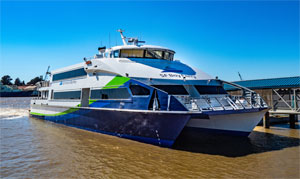With the sun rising, Pyxis made its way up the Napa River and docked at the Vallejo Ferry Terminal. In 15 minutes, loaded with commuters, the fast catamaran backed out of its slip and headed for the San Francisco Ferry Building on the Embarcadero, one hour away.
The new ferry, the first of three scheduled to join the Water Emergency Transportation Authority (WETA) fleet by early 2020, has quickly become a familiar sight on the Vallejo-San Francisco run. In addition to boosting capacity on the busy route, Pyxis is also carrying another torch: It is the first passenger ferry in the United States with EPA Tier 4 emissions controls. The newbuild’s MTU engines, currently undergoing emissions testing, are expected to be Tier 4 certified in the near future.
The 143-foot Pyxis was designed by Advanced Multihull Designs (AMD) of Australia and built by Dakota Creek Industries in Anacortes, Wash. When sisters Lyra and Vela are delivered, Dakota Creek — no stranger to the Bay Area’s busy water transportation system — will have built six fast ferries for WETA. Three more operate in the Golden Gate Ferry fleet.
The region’s highways, bridges, buses, trains and ferries are choked with commuters every weekday. The speed and capacity of the new ferries, with each accommodating up to 445 passengers, will help WETA handle a projected 900 percent increase in ridership by 2035. The ferry service expects to add 44 vessels to its fleet by then.
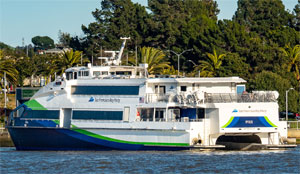 |
|
The ferry, shown in Vallejo, makes two morning runs and two late-afternoon runs. Its 34-knot service speed allows it to complete each transit in one hour. |
The Vallejo-San Francisco route is WETA’s longest and most popular run. Pyxis conducts two morning and two late-afternoon commuter transits.
“Vallejo ferry passengers are going to love riding Pyxis,” Nina Rannells, WETA’s executive director, said when the ferry was delivered in March. “Our ridership has doubled since 2012, and we are working to grow our fleet to accommodate this growth. Pyxis is perfectly suited for Vallejo service with the highest passenger capacity in our fleet and a 34-knot speed.”
The design criteria for the new ferry required it to carry 100 more passengers than previous AMD ferries, maintain a 34-knot service speed to complete the Vallejo run in one hour, and have a pollution control system that would satisfy California’s hunger for clean air. Pyxis also had to be compatible with existing docks and boarding ramps, and have the same bow servicing system for fuel, sewage, potable water and shore power as the existing fleet.
“There is a lot of redundancy, and the general deck layout in regard to boarding, fire stations and galley locations is the same (as other boats in the fleet),” said Peter Belden, WETA’s Vallejo operations manager. “So the day-to-day interactions of the crews is similar for each class of boat. The concept has reduced and streamlined crew training, and we can switch out crewmembers, if necessary, without causing confusion.”
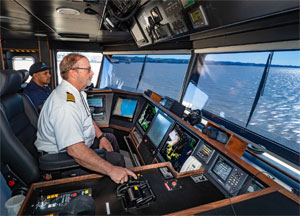 |
|
Capt. Gene Tracy mans the helm and deck hand Christopher Allard keeps watch as Pyxis crosses San Pablo Bay on a late-afternoon return trip to San Francisco. |
Pyxis — named for a small constellation and abbreviated from Pyxis Nautica, Latin for “mariner’s compass” — is the 11th ferry in WETA’s 14-vessel fleet with MTU propulsion. The newbuild is powered by two MTU 16V 4000 M65 engines rated at 3,433 hp each, driving a pair of HamiltonJet waterjets through ZF gears. The propulsion integration was carried out by Pacific Power Group of Kent, Wash. The engines are part of the field testing for MTU’s Tier 4 system.
“Our system is based on an airless dosing, whereby we inject urea into the (exhaust) system via a pump,” said Jeff Sherman, senior commercial marine sales manager for MTU America.” The benefit is that for installation of the MTU engines, other than a lift pump from the urea tank there is nothing else to purchase or install.”
Sherman explained that the selective catalytic reduction (SCR) system injects the proper amount of urea based on several engine parameters, such as engine load and rpm. The system reduces nitrogen oxide (NOx) emissions to the limits required by Environmental Protection Agency Tier 4 regulations.
“The system is proven, and current field test engines are showing very positive results both in emissions and maintenance,” he said.
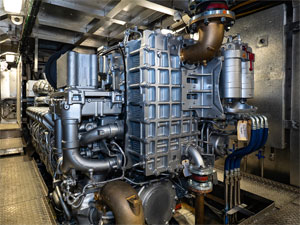 |
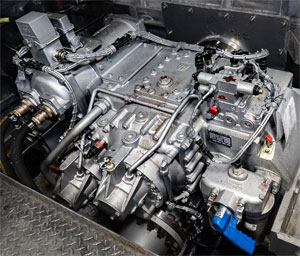 |
|
|
At the heart of Pyxis are a pair of MTU 16V 4000 M65 engines, left, delivering a combined 6,866 horsepower and a top speed of 38 knots. HamiltonJet HT810 waterjets, right, are the boat’s “best attribute” and “the cat’s meow,” says Capt. Gene Tracy. |
||
Belden said that the SCR units, located at the back of the engine rooms, provide enough exhaust noise attenuation that WETA was able to eliminate the mufflers normally located in the aft machinery spaces with the gears and waterjets.
“That opens up a lot of extra room and reduces the heat in these spaces,” he said. “That also gave us a little less weight in the stern, which is what we wanted, so the boat trims better. These boats are really weight- and trim-sensitive.”
Hollie Anthonysz, Dakota Creek’s vice president of programs, said the two MTU engines, with generously sized SCRs, “challenged our design engineering team early on, as the space required careful placement.” The emissions system also required specialized piping and tanks for the diesel exhaust fluid. She said the process of fitting it all together went smoothly because of early planning.
“(Dakota Creek) worked closely with the naval architects and MTU to ensure the proper arrangement was achieved for ease of access and maintainability, as well as proper airflow, just to name a few things,” Anthonysz said.” Installing this equipment in a confined space is always challenging, so planning is critical.”
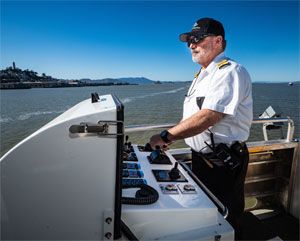 |
|
Tracy mans the controls on the starboard bridge wing as he guides the vessel to its slip at the San Francisco Ferry Terminal. |
On the bridge, Pyxis’ forward-facing windows are raked upward for less glare, better protection from the rain, and more headroom for overhead control panels. “There is great visibility because of the window design,” said Capt. Gene Tracy, who was at the helm for the afternoon run to Vallejo.
After taking on passengers at the Vallejo terminal, Tracy eased Pyxis down the Napa River, into San Pablo Bay and pushed on the throttles for the return trip to San Francisco. Deck hand Christopher Allard joined the bridge when the ferry left the Napa River, satisfying a requirement that two people be on watch once a vessel is doing 30 knots or more.
With an ebb current, Pyxis made as much as 37 knots with total disregard for the chop. “These catamarans are very stable when it’s choppy,” Tracy said. “The monohulls are a lot less pleasant for the passengers.” The captain also had praise for the HamiltonJet waterjets, which he said were the boat’s “best attribute. I believe they are the cat’s meow. They allow you great maneuverability.”
The passenger lounges, on two decks, are well appointed and comfortable, a fact attested to by several commuters who were sprawled and sleeping in their seats. Many other passengers were glued to the expansive windows, taking in the sweeping views of the bay awash in afternoon sunlight. A few braved the stiff wind sweeping the open aft deck.
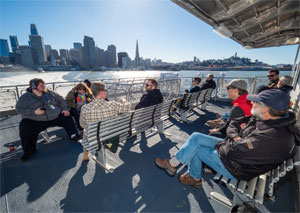 |
|
Passengers enjoy spectacular views of the San Francisco skyline from the aft deck as Pyxis makes its way from the Embarcadero terminal. |
“From a passenger point of view, the layout of the decks and the amount of seating and comfort, it works,” Allard said. “When we get to 300, the passengers are not rushing to board because they know they can get a seat. And it has great ADA (Americans with Disabilities Act) features. The handicap facilities work very well.”
Another attribute for commuters is the covered deckhouse on the stern with storage for 30 bicycles. The boat’s hull was extended two frames to create the space for it.
Nearing the ferry building in San Francisco, Tracy slowed Pyxis and moved out to the starboard bridge wing to ease the ferry into the slip. “When I’m docking, I use the flag on top of the ferry terminal tower to gauge the wind,” he said.
Allard was soon joined by deck hands Rashonda Simms and John Chiovarou to assist passengers off the ferry. Within 15 minutes, a full load of home-bound commuters was aboard and Tracy was back at the bridge wing, easing Pyxis out of the slip for the return run to Vallejo.

